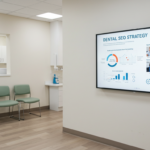How to Do Digital Marketing: Your Ultimate Step-by-Step Guide for 2025
Digital marketing isn’t just a buzzword—it’s the engine that drives modern business growth. But with so many platforms, tools, and strategies out there, where do you even start? This guide cuts through the noise and gives you a clear, actionable roadmap to build, execute, and refine a digital marketing strategy that delivers real results. Let’s dive in.
Step 1: Lay the Foundation
Before launching ads or writing blogs, you need a solid plan. Skipping this step is like building a house on sand—it might look good at first, but it won’t last.
Define Your Goals
What do you want to achieve? Be specific:
- Increase website traffic by 50% in 6 months.
- Generate 100 qualified leads per month.
- Boost online sales by 30% by Q4.
Goals should follow the SMART framework: Specific, Measurable, Achievable, Relevant, Time-bound.
Understand Your Audience
Who are you targeting? Create detailed buyer personas:
- Demographics: Age, gender, location, income.
- Pain Points: What problems do they need solved?
- Behaviour: Where do they spend time online?
Use tools like Google Analytics, social media insights, or surveys to gather data. For example, a plumbing company might discover that 70% of their customers search for “emergency plumber near me” on mobile devices.
Analyse Competitors
Identify 3-5 competitors and dissect their strategies:
- What keywords are they ranking for? (Use SEMrush or Ahrefs)
- Which social platforms do they dominate?
- What gaps can you exploit?
Our guide on how to find competitors’ PPC keywords can streamline this process.
Step 2: Build Your Digital Marketing Toolkit
Digital marketing thrives on the right tools. Here’s what you need:
| Category | Tools | Use Case |
|---|---|---|
| SEO | SEMrush, Ahrefs, Screaming Frog | Keyword research, site audits |
| PPC | Google Ads, Meta Ads Manager | Run and optimise paid campaigns |
| Content | Grammarly, Canva, BuzzSumo | Create and distribute content |
| Social Media | Hootsuite, Later, Sprout Social | Schedule posts, track engagement |
| Email Marketing | Mailchimp, Klaviyo, ConvertKit | Nurture leads, automate campaigns |
| Analytics | Google Analytics 4, Hotjar, Google Search Console | Track performance, user behaviour |
Pro Tip: Start with free tools like our Google Business Profile SEO Checker to audit local SEO efforts.
Step 3: Master SEO for Long-Term Growth
SEO is the backbone of organic growth. Here’s how to do it right:
Keyword Research
Find terms your audience is searching for. For example, a bakery in London might target “best sourdough bread in London” or “gluten-free birthday cakes”.
- Tools: Use Google Keyword Planner, AnswerThePublic, or our guide on how to find SEO keywords.
- Focus on Intent: Prioritise informational (“how to”), navigational (“brand name”), and transactional (“buy”) keywords.
On-Page SEO
Optimise every page for both users and search engines:
- Titles & Meta Descriptions: Include keywords naturally. Keep titles under 60 characters.
- Headers (H1, H2, H3): Structure content clearly. Use keywords in H2s.
- Content Quality: Aim for comprehensive, original content. For instance, a 2,000-word guide on “How to Design a Website” outperforms thin 500-word posts.
- Internal Linking: Link to related pages on your site (e.g., What is SEO?).
Technical SEO
Fix backend issues that hurt rankings:
- Speed: Compress images, leverage browser caching. Aim for a load time under 2 seconds.
- Mobile-Friendliness: Use Google’s Mobile-Friendly Test.
- XML Sitemap: Submit to Google Search Console.
- Fix Broken Links: Use Screaming Frog to identify 404 errors.
For a deep dive, follow our technical SEO checklist.
Off-Page SEO
Build authority through backlinks:
- Guest Posting: Write for reputable sites in your niche.
- Local Citations: Ensure your business is listed on Google My Business, Yell, and industry directories.
- Social Signals: Share content on LinkedIn, Twitter, and niche forums.
Step 4: Launch Strategic PPC Campaigns
PPC delivers instant visibility. Here’s how to do it without burning your budget:
Choose the Right Platform
- Google Ads: Ideal for high-intent searches (e.g., “buy running shoes”).
- Meta Ads: Great for visual products (e.g., fashion, home decor).
- LinkedIn Ads: Target B2B decision-makers.
Craft Compelling Ads
- Headlines: Use urgency or curiosity (“Last 5 Units Left!” or “Discover the Secret to Perfect Skin”).
- CTAs: Direct and action-oriented (“Book Now”, “Get 50% Off”).
- Ad Extensions: Add sitelinks, call buttons, or reviews for credibility.
Optimise for Conversions
- A/B Test: Experiment with different headlines, images, and CTAs.
- Landing Pages: Ensure alignment with ad messaging. For example, an ad for “SEO Services” should lead to an SEO service page, not your homepage.
- Negative Keywords: Block irrelevant searches (e.g., “free SEO tools” if you sell premium services).
Learn more in our step-by-step PPC guide.
Step 5: Create Content That Converts
Content builds trust and drives organic traffic. Follow this framework:
Blog Posts
- Solve Problems: Answer questions like “How to Design a Website from Scratch” or “Why is CRM Important?”.
- Optimise for SEO: Use keywords in the first 100 words and headers.
- Update Regularly: Refresh old posts with new data (e.g., “2025 Email Marketing Trends”).
Video Content
- Short-Form: TikTok or Instagram Reels for quick tips.
- Long-Form: YouTube tutorials or webinars for in-depth guides.
- Live Streams: Host Q&A sessions to engage audiences in real time.
Email Marketing
- Segment Lists: Send personalised offers based on behaviour (e.g., cart abandoners vs. loyal customers).
- Automate Workflows: Welcome series, post-purchase follow-ups, or re-engagement campaigns.
- Track KPIs: Open rates, click-through rates, conversions. See our email marketing KPIs guide.
Step 6: Dominate Social Media
Social platforms are where relationships are built. Here’s how to stand out:
Pick 2-3 Platforms
- B2B: LinkedIn, Twitter, YouTube.
- B2C: Instagram, TikTok, Facebook.
- Local Businesses: Facebook Groups, Google My Business.
Create a Content Calendar
- Weekly Posts: Mix educational, promotional, and engaging content.
- Educational: “5 Signs Your Website Needs an SEO Audit”.
- Promotional: “Limited-Time Offer: 20% Off SEO Services”.
- Engaging: Polls, quizzes, user-generated content.
Run Targeted Ads
- Custom Audiences: Retarget website visitors or email subscribers.
- Lookalike Audiences: Reach users similar to your best customers.
- A/B Test Creatives: Test videos vs. carousels, different captions, or CTAs.
For local businesses, pair social ads with local SEO strategies.
Step 7: Optimise for Conversions
Traffic means nothing without conversions. Master these tactics:
Improve Website UX
- Simplify Navigation: Users should find info in 3 clicks or fewer.
- Mobile-First Design: 60% of searches happen on mobile.
- Clear CTAs: Use contrasting colours and action verbs (“Download Now”, “Start Free Trial”).
A/B Test Everything
- Test headlines, images, button colours, and page layouts.
- Use tools like Google Optimize or Optimizely.
Use Trust Signals
- Reviews, testimonials, security badges (e.g., “SSL Secured”).
For advanced strategies, explore our conversion rate optimisation best practices.
Step 8: Measure, Analyse, Iterate
Digital marketing is a cycle—not a one-off project.
Track Key Metrics
| Channel | Key Metrics |
|---|---|
| SEO | Organic traffic, keyword rankings, bounce rate |
| PPC | Click-through rate (CTR), cost per conversion |
| Social Media | Engagement rate, follower growth, shares |
| Open rate, conversion rate, unsubscribe rate |
Adjust Your Strategy
- Double down on what works (e.g., TikTok drives 80% of your sales? Post daily).
- Kill underperforming campaigns (e.g., LinkedIn Ads with a 0.5% CTR).
- Stay agile: Adapt to algorithm changes or new trends (e.g., AI-powered chatbots).
Audit Quarterly
- Review SEO rankings, PPC ROI, and content performance.
- Use tools like Google Analytics 4 and our free On-Page SEO Checker.
Final Word
Digital marketing isn’t about chasing every trend—it’s about executing the basics flawlessly and staying adaptable. By following this step-by-step guide, you’ll build a strategy that drives traffic, generates leads, and boosts sales.
At Tom Wilson Digital, we specialise in turning complexity into clarity. Whether you’re crafting a data-driven SEO strategy or refining your social media advertising, we’re here to help you succeed.
Now, it’s your turn to take action. Start with one step today—audit your website, research keywords, or draft your first blog post. Consistency is key, and the results will follow.
FAQs
It varies depending on the strategy. SEO can take months, while PPC ads might deliver instant traffic. Consistency is key to long-term success.
It depends on your audience and industry. For example, Instagram is great for visual content, while LinkedIn is ideal for B2B marketing.
Yes, many small business owners start by managing their own digital marketing. However, as your business grows, you may want to hire a specialist.
Your budget depends on your goals, but it’s essential to start small and scale up as you see results. PPC ads can be cost-effective, but SEO and content marketing are long-term investments.
Blog posts, videos, and social media updates tend to perform well. The key is to create content that is relevant and valuable to your audience.










